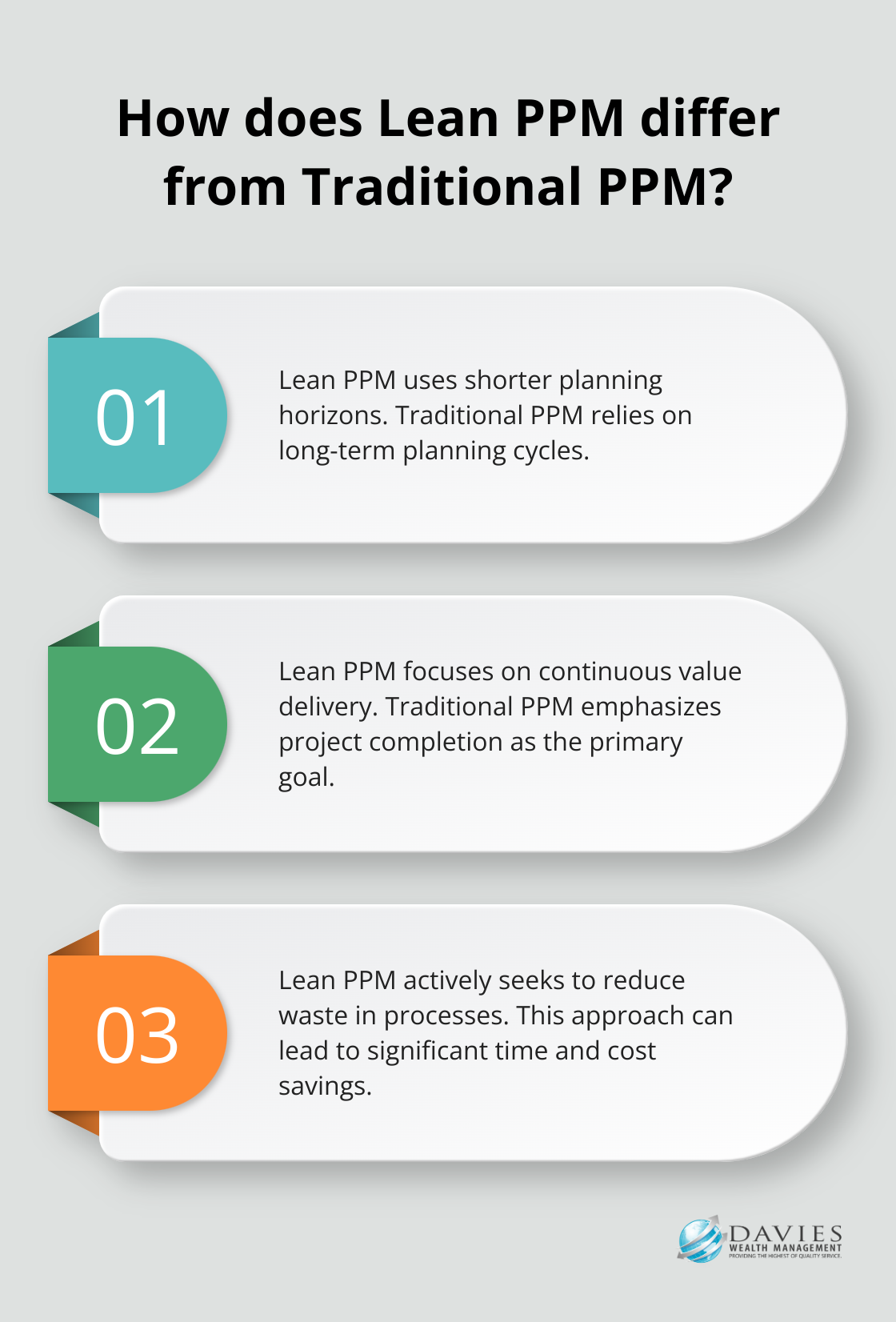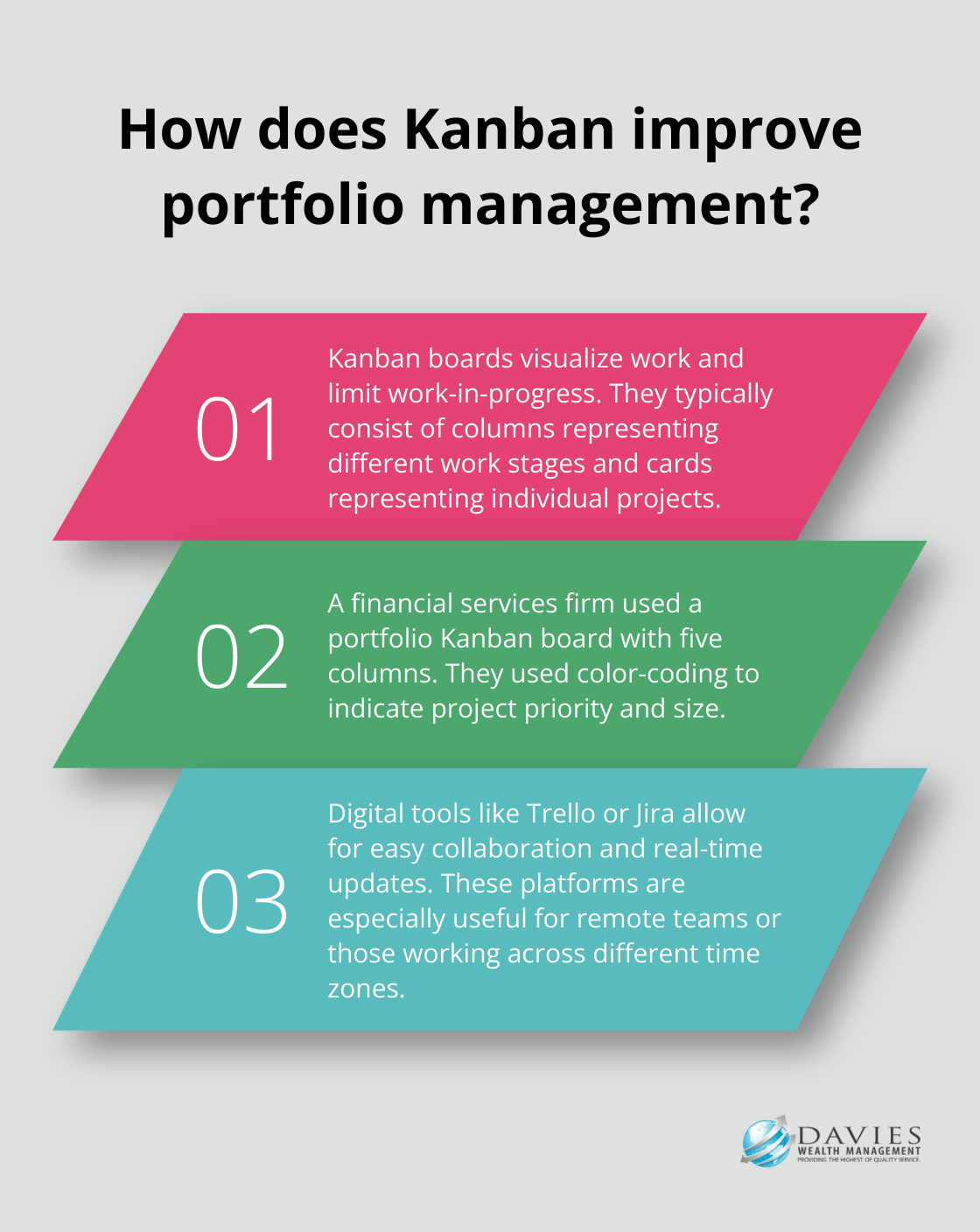At Davies Wealth Management, we understand the importance of efficient project management in today’s fast-paced business environment. Lean Project Portfolio Management (PPM) has emerged as a powerful approach to streamline operations and maximize value.
This comprehensive guide explores the principles, benefits, and implementation strategies of this innovative project portfolio management model. We’ll delve into practical tools and techniques that can help organizations optimize their project portfolios and drive success.
Understanding Lean Project Portfolio Management
Definition and Core Principles
Lean portfolio management is a process that aligns strategy with execution using a lean approach and agile portfolio operations and governance. This strategic approach maximizes value delivery while minimizing waste in project management processes.

The foundation of lean PPM rests on several key principles:
- Continuous Flow: Lean PPM aims to reduce bottlenecks and delays in project execution.
- Customer Value Focus: Projects must align closely with organizational goals and stakeholder needs.
- Continuous Improvement Culture: Teams regularly reflect on and refine their processes.
Proper use of Lean techniques can result in cutting waste in projects, producing greater customer satisfaction and improved profit margin.
Benefits of Lean Approach in Portfolio Management
Implementing lean PPM offers numerous advantages for organizations:
- Improved Resource Allocation: Companies can use their limited resources more efficiently by focusing on high-value projects and eliminating unnecessary work.
- Enhanced Flexibility: Lean PPM enables organizations to respond more quickly to changing market conditions or shifting priorities. This agility is particularly important in today’s fast-paced business environment, where the ability to pivot quickly can be a significant competitive advantage.
- Continuous Value Delivery: Instead of focusing solely on project completion, lean PPM prioritizes the ongoing delivery of value to stakeholders throughout the project lifecycle. This shift in focus can lead to more meaningful outcomes and higher stakeholder satisfaction.
Key Differences from Traditional Portfolio Management
Lean PPM differs from traditional approaches in several important ways:
- Planning Horizons: Traditional PPM often relies on rigid, long-term planning cycles. In contrast, lean PPM embraces shorter planning horizons and more frequent reassessment of priorities. This allows for greater adaptability and responsiveness to changing conditions.
- Value Focus: While traditional PPM often emphasizes project completion as the primary goal, lean PPM places a stronger emphasis on continuous value delivery. This approach ensures that projects consistently align with organizational objectives and stakeholder needs.
- Waste Reduction: Lean PPM actively seeks to identify and eliminate waste in project management processes (such as unnecessary meetings or excessive documentation). This focus on efficiency can lead to significant time and cost savings.
- Empowerment: Lean PPM often involves decentralized decision-making, empowering teams to make quick decisions and adapt to changing circumstances. This contrasts with the more hierarchical structure often found in traditional PPM approaches.
As organizations continue to seek ways to improve their project management practices, lean PPM offers a promising approach. The next section will explore practical strategies for implementing lean PPM in your organization.
How to Implement Lean Project Portfolio Management
At Davies Wealth Management, we’ve observed the transformative power of Lean Project Portfolio Management (PPM) in enhancing project delivery. This approach focuses on maximizing value and efficiency throughout the project lifecycle, rather than merely reducing costs.
Identify and Eliminate Waste
The first step in implementing Lean PPM involves the identification and elimination of waste in portfolio processes. Waste can manifest in various forms, such as superfluous meetings, excessive documentation, or redundant approval processes.

A value stream mapping exercise proves effective in this regard. This method requires the visualization of the entire portfolio management process from inception to completion, pinpointing areas where work stagnates or resources remain underutilized. For instance, you might uncover projects languishing for weeks, awaiting approvals that could be streamlined.
After identifying these waste areas, take decisive action to eliminate them. This might involve the automation of routine tasks, reduction of approval stages, or empowerment of teams to make decisions at lower levels.
Embrace Continuous Improvement
Lean PPM isn’t a one-off implementation; it requires ongoing refinement and adaptation. Establish regular review cycles where teams can reflect on effective practices and areas needing improvement. These “retrospectives” should yield specific changes to your portfolio management approach.
The A3 problem-solving method (developed by Toyota) offers a practical way to drive continuous improvement. This technique involves documenting problems, analysis, corrective actions, and results on a single sheet of paper. It compels teams to distill complex issues into their essential elements and develop targeted solutions.
Prioritize Based on Value Streams
Lean PPM prioritizes projects based on their alignment with organizational value streams-the end-to-end processes that deliver value to customers. This focus on value streams (rather than individual projects) ensures that your portfolio always aligns with strategic objectives.
To implement this approach, start by clearly defining your organization’s value streams. Then, evaluate each project or initiative based on its contribution to these streams. Techniques like Weighted Shortest Job First (WSJF) can help prioritize work items. This method considers both the cost of delay and the duration of work, helping you focus on high-value, quick-win initiatives.
Visualize Portfolio Workflow
Visualization, a key principle of Lean thinking, proves particularly powerful in portfolio management. Create a visual representation of your project portfolio that displays the status of all initiatives, their alignment with value streams, and any bottlenecks or dependencies.
Many organizations use portfolio Kanban boards for this purpose. These boards provide a real-time view of work in progress, helping to identify overloaded resources or stalled projects. They also facilitate the enforcement of work-in-progress (WIP) limits, preventing teams from taking on more than they can handle effectively.
The implementation of Lean PPM requires commitment and cultural change. While it presents challenges, the benefits-improved efficiency, faster delivery, and better alignment with strategic goals-make it a worthwhile endeavor. As we transition to the next chapter, we’ll explore the specific tools and techniques that can support your Lean PPM journey, providing practical ways to put these principles into action.
Practical Tools for Lean Portfolio Management
Kanban Boards for Portfolio Visualization
Kanban boards transform how organizations view and manage project portfolios. These visual management tools are designed to help visualize work, limit work-in-progress, and maximize efficiency. They typically consist of columns representing different work stages (e.g., “To Do,” “In Progress,” “Done”) and cards representing individual projects or initiatives.

A financial services firm implemented a portfolio Kanban board with columns for “Proposed,” “Analyzing,” “Approved,” “In Progress,” and “Completed.” This allowed them to see which projects moved forward and which stalled. They used color-coding to indicate project priority and size, making it easy to spot high-value initiatives.
To start with a portfolio Kanban board, try digital tools like Trello or Jira. These platforms allow for easy collaboration and real-time updates, which proves especially useful for teams working remotely or across different time zones.
Value Stream Mapping for Process Optimization
Value stream mapping helps identify waste and optimize processes. It’s an analysis technique that can help optimize your continuous delivery pipeline, streamlining the flow of work from idea generation to project completion.
A manufacturing company analyzed their project approval process using value stream mapping. They discovered projects spent an average of three weeks waiting for executive sign-off, creating a significant bottleneck. By redesigning their approval process and empowering mid-level managers to make certain decisions, they reduced this wait time to just three days.
To create a value stream map for your portfolio management process, document each step from project proposal to completion. Note the time spent at each stage and identify areas where work accumulates. This visual representation will help you spot inefficiencies and opportunities for improvement.
A3 Problem-Solving for Continuous Improvement
The A3 problem-solving method (named after the paper size it traditionally used) provides a structured approach to identifying, understanding, and resolving issues. It proves particularly useful for addressing recurring problems in portfolio management.
A tech startup used the A3 method to tackle their issue of frequently missing project deadlines. Their A3 report included sections for problem statement, current state, root cause analysis, target state, and proposed countermeasures. This structured approach helped them identify that unrealistic time estimates were a key factor in their delays. As a result, they implemented a new estimation process that improved their on-time delivery rate by 40%.
To implement A3 problem-solving in your organization, start with a clear problem statement. Then, work through each section of the A3 report, involving team members from different areas to gain diverse perspectives. The goal extends beyond solving the immediate problem; it aims to prevent its recurrence.
Portfolio Backlog Management
Effective portfolio backlog management ensures that organizations focus on the most valuable initiatives. This tool helps prioritize projects based on their alignment with strategic objectives and potential return on investment.
Try using a scoring system to rank projects in your portfolio backlog. Criteria might include strategic alignment (how well the project supports organizational goals), financial impact (expected ROI), risk level, and resource requirements. Regularly review and update this backlog to ensure it reflects current business priorities.
Some organizations use specialized portfolio management software (such as Planview or Clarity PPM) to manage their backlogs effectively. These tools often include features for project scoring, resource allocation, and scenario planning.
Final Thoughts
Lean Project Portfolio Management transforms project management by maximizing value and efficiency. This project portfolio management model streamlines processes, reduces waste, and aligns projects with strategic objectives. Organizations that implement Lean PPM enhance resource allocation, increase flexibility, and ensure continuous value delivery throughout the project lifecycle.

The future of Lean PPM will likely incorporate artificial intelligence and machine learning tools to enhance decision-making processes. We also expect an increased focus on sustainability within project portfolios, aligning with growing environmental concerns. These advancements will further optimize project management and drive organizational success.
At Davies Wealth Management, we apply similar principles of efficiency to financial management. Our personalized wealth management services optimize your financial portfolio, offering comprehensive advisory services including cash flow optimization, retirement planning, and investment management. We prioritize trust and transparency to prepare you for current and future financial challenges.
✅ BOOK AN APPOINTMENT TODAY: https://davieswealth.tdwealth.net/appointment-page
===========================================================
SEE ALL OUR LATEST BLOG POSTS: https://tdwealth.net/articles
If you like the content, smash that like button! It tells YouTube you were here, and the Youtube algorithm will show the video to others who may be interested in content like this. So, please hit that LIKE button!
Don’t forget to SUBSCRIBE here: https://www.youtube.com/channel/UChmBYECKIzlEBFDDDBu-UIg
✅ Contact me: TDavies@TDWealth.Net
====== ===Get Our FREE GUIDES ==========
Retirement Income: The Transition into Retirement: https://davieswealth.tdwealth.net/retirement-income-transition-into-retirement
Beginner’s Guide to Investing Basics: https://davieswealth.tdwealth.net/investing-basics
✅ Want to learn more about Davies Wealth Management, follow us here!
Website:
Podcast:
Social Media:
https://www.facebook.com/DaviesWealthManagement
https://twitter.com/TDWealthNet
https://www.linkedin.com/in/daviesrthomas
https://www.youtube.com/c/TdwealthNetWealthManagement
Lat and Long
27.17404889406371, -80.24410438798957
Davies Wealth Management
684 SE Monterey Road
Stuart, FL 34994
772-210-4031
#Retirement #FinancialPlanning #wealthmanagement
DISCLAIMER
The content provided by Davies Wealth Management is intended solely for informational purposes and should not be considered as financial, tax, or legal advice. While we strive to offer accurate and timely information, we encourage you to consult with qualified retirement, tax, or legal professionals before making any financial decisions or taking action based on the information presented. Davies Wealth Management assumes no liability for actions taken without seeking individualized professional advice.



Leave a Reply